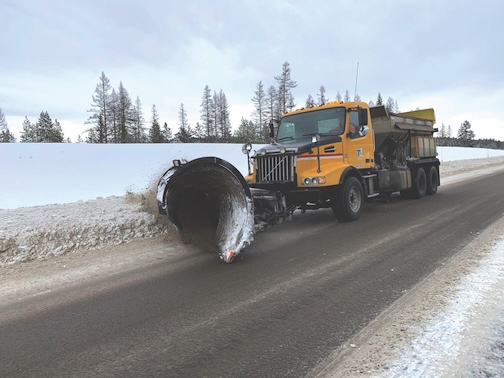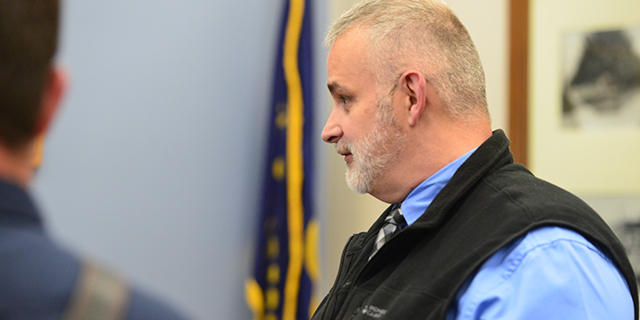BIG SCHOOL EDUCATION WITH SMALL SCHOOL APPEAL
Published 12:00 am Monday, September 25, 2006

- DETAILED WORK: Rangeland ecology and management major David Brock is counting hard red winter wheat seeds in preparation for seed trials. Brock is working with the OSU Extension agent Darrin Walenta. Students and faculty from the local OSU Ag Program often cooperate with other schools, agencies, commodity groups and land managers on projects over several counties in the region. (Observer photos/MARDI FORD).
– Mardi Ford
Trending
– The Observer
David Brock likes to laugh. A big guy with a broad smile, Brock is a soon-to-be ex-logger from Washington and a senior enrolled in the Oregon State University Agriculture Program on the Eastern Oregon University campus.
Brock pauses in his seed counting project to talk about his educational experience. When asked what drew him to the La Grande program, Brock gestures toward Larry Larson and says, "The big ‘L’ here."
Trending
Both he and Larson, the program’s coordinator and professor of rangeland ecology and management, bust out laughing at that one.
In the background, Gary Kiemnec, crop and soil science associate professor, grins and fires off a quick remark, then gets one aimed right back at him.
"You know they’re twins, don’t you?" Brock asks, referring to the two bearded professors.
But with all the familiarity and camaraderie, one thing is obvious there is also mutual respect. And it quickly becomes apparent that behind Brock’s ready humor is a knowledgeable student with an intense passion for finding and implementing solutions to the challenges of rangeland management.
One challenge, Brock explains, is the loss of connection between people and the land. Society has forgotten that not only the food they eat, but the homes they build and everything they fill them with are made from components harvested from the land.
"Everything we have in our lives everything from Twinkie wrappers to glasses. It’s all extracted from the land. All of it. People don’t understand that anymore," he says.
Farmers, he adds, do understand the need for sustaining the earth because their lives depend on it.
"The people who cry about overgrazing or how terrible the grassland looks right now with horses eating it down to this," he says, pinching two fingers together. "It’s grass. Just wait and see. Next spring," he spreads his hands a foot apart, "it’s going to be this tall again."
Brock is an older student, married, with a family. He’s what the university system would categorize as nontraditional. But he never considered the distance learning program, designed with the nontraditional student in mind, choosing instead to move his family to La Grande. For Brock, the firsthand experience was essential.
"I wanted the one-on-one. And I was advised this program was one of the best," he says.
This fall, the ag program at EOU will provide 167 students 38 of them new enrollees with an agriculture education at its firsthand best.
This year there are three Canadian students and 38 from out of state from as far away as Alaska and Oklahoma. Of the Oregon students, approximately 36 of them are from west of the Cascades with the remaining 90 from Central and Eastern Oregon.
"A lot of kids come here because they want the OSU ag degree, but they can’t afford to go to Corvallis, or they don’t want to be in a big school," says JoLyn Scott, the program’s office coordinator.
The profile of the average ag student shows approximately 60 percent of them come from rural Eastern Oregon, as well as other states like California, Washington, Idaho and Nevada.
"Surprisingly, a lot of our enrollment is also from the other side of the state. Kids from small high schools and rural communities on the west side don’t necessarily want to go to a big school like Corvallis,” Scott says. "They like the small town feel of
La Grande and the personal attention they can get in our program. Something our students really value is that relationship they forge with their professors and advisers."
Brock agrees.
"You go to a big school and you’re just one person in this great big classroom. You don’t get that one-on-one interaction with your professors like you do here," he says.
Besides Larson, Kiemnec and Scott, program staff also includes four other resident OSU faculty Mike McInnis, professor of rangeland ecology and management; Andy Huber, crop and soil science; and Penny Diebel and Laura Gow, who both teach ag and resource economics. There are also the three research scientists from the OSU Agricultural Research Center in Union who rotate in for classes on alternating terms: Tim Del Curto, John Tanaka and Pat Kennedy.
Larson says the average class size in the EOU program lies somewhere between 25 and 30 about the same number of students enrolled in the program the year it started in the fall of 1984. That year, the entire program was 25 students and two professors Larson, who taught range science, and Art Greer, who taught ag business and also headed the program.
"That we even have a program here is to Art’s credit,” Larson says. "There are three people who deserve the recognition for this program. Art and (former EOU President) Dave Gilbert worked tirelessly with OSU to get the program here. And (former State Sen.) Mike Thorne, who was instrumental in getting the money."
The program began in two rooms of Zabel Hall offering a single degree in Ag Business and an enrollment goal of 50 students. Over the next two years, two new faculty members were added each year and enrollment increased. Kiemnec came on board in 1986 to teach crop and soil science.
"Yeah, I’ve pretty much been here since the beginning, too," he says.
"You may have noticed, we don’t have a huge turnover in faculty here," Larson says with a grin.
When the new science center was opened in Badgley Hall in Spring 2003, the Ag Program happily moved in.
"We more than doubled our space," Larson says.
From a teaching perspective, Kiemnec says the move into the new science center gave them designated lab space, as well as a functioning greenhouse with more room than they’d ever had.
Having that lab available longer is a great benefit to students, he adds.
Students now choose from an agriculture and natural resource education program that offers five bachelor of science degrees in agricultural business management; environmental economics, policy and management; crop and soil science, natural resources; and rangeland ecology and management. In addition, seven minors are offered in agricultural business management, resource economics, natural resource environmental law and policy, animal science, crop science, rangeland ecology and management and fish and wildlife.
Campus activity and outreach through the program includes both the Ag and Range clubs, Collegiate FFA and the newly chartered Pacific Northwest Society for Range Management.
For more information, visit the Web site, www.eou.edu/osuag , call Scott at 962-3612 or e-mail jolyn.scott@eou.edu .









